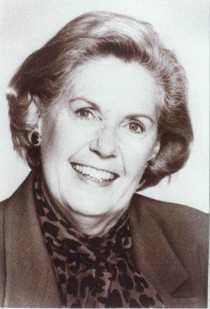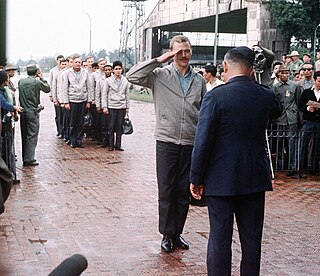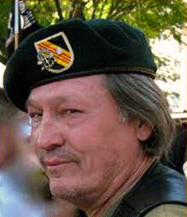
A POW bracelet, also known as a POW/MIA bracelet, is a nickel-plated or copper commemorative bracelet engraved with the rank, name, and loss date of an American servicemen captured or missing in Southeast Asia during the Vietnam War.

A POW bracelet, also known as a POW/MIA bracelet, is a nickel-plated or copper commemorative bracelet engraved with the rank, name, and loss date of an American servicemen captured or missing in Southeast Asia during the Vietnam War.
The POW bracelet was conceived in 1970 by Carol Cates Brown and Kay Hunter, members of the California-based student group Voices in Vital America (VIVA), [1] with the intention that American prisoners of war in Southeast Asia not be forgotten. [2] Those who wore the bracelets vowed to leave them on until the serviceman named on the bracelet, or their remains, were returned to the United States, [3] with the idea of returning the bracelet to the returning prisoner. [4] [5] [6]
The bracelets, which cost 30 cents to produce, sold for $2.50 or $3.00 and increased VIVA's income to more than $7 million by 1973. Between 1970 and 1973, approximately 4 million bracelets were distributed. [2] Politicians, entertainers, and models wore the bracelets. [3]

Douglas Brian "Pete" Peterson is an American politician and diplomat. He served as a United States Air Force pilot during the Vietnam War and spent over six years as a prisoner of the North Vietnamese army after his plane was shot down. He returned to Hanoi when he became the first United States Ambassador to Vietnam in 1997. He was an ambassador until July 2001, after which he devoted himself to philanthropic work.

Hỏa Lò Prison was a prison in Hanoi originally used by the French colonists in Indochina for political prisoners, and later by North Vietnam for U.S. prisoners of war during the Vietnam War. During this later period, it was known to American POWs as the "Hanoi Hilton". Following Operation Homecoming, the prison was used to incarcerate Vietnamese dissidents and other political prisoners, including the poet Nguyễn Chí Thiện. The prison was demolished during the 1990s, although its gatehouse remains a museum.

Missing in action (MIA) is a casualty classification assigned to combatants, military chaplains, combat medics, and prisoners of war who are reported missing during wartime or ceasefire. They may have been killed, wounded, captured, executed, or deserted. If deceased, neither their remains nor grave have been positively identified. Becoming MIA has been an occupational risk for as long as there has been warfare.

Sybil Elizabeth Stockdale was an American campaigner for families of Americans missing in South East Asia.

The Joint POW/MIA Accounting Command was a joint task force within the United States Department of Defense (DoD) whose mission was to account for Americans who are listed as Prisoners of War (POW), or Missing in Action (MIA), from all past wars and conflicts. It was especially visible in conjunction with the Vietnam War POW/MIA issue. The mission of the Joint POW/MIA Accounting Command was to achieve the fullest possible accounting of all Americans missing as a result of the nation's past conflicts. The motto of JPAC was "Until they are home".

Operation Homecoming was the return of 591 American prisoners of war (POWs) held by North Vietnam following the Paris Peace Accords that ended U.S. involvement in the Vietnam War.

The National League of Families of American Prisoners and Missing in Southeast Asia, commonly known as the National League of POW/MIA Families or the League, is an American 501(c)(3) humanitarian organization that is concerned with the Vietnam War POW/MIA issue. According to the group's web site, its sole purpose is "to obtain the release of all prisoners, the fullest possible accounting for the missing and repatriation of all recoverable remains of those who died serving our nation during the Vietnam War in Southeast Asia." The League's most prominent symbol is its flag.

The National League of Families POW/MIA flag, often referred to as the POW/MIA flag, was adopted in 1972 and consists of the official emblem of the National League of Families of American Prisoners and Missing in Southeast Asia in white on a black background. In 2019, the National POW/MIA Flag Act was signed into law, requiring the POW/MIA flag to be flown on certain federal properties, including the U.S. Capitol Building, on all days the U.S. flag is flown.
The Senate Select Committee on POW/MIA Affairs was a special committee convened by the United States Senate during the George H. W. Bush administration to investigate the Vietnam War POW/MIA issue, that is, the fate of United States service personnel listed as missing in action during the Vietnam War. The committee was in existence from August 2, 1991 to January 2, 1993.
The National Alliance of Families for the Return of America's Missing Servicemen is an American organization founded in 1990. Its goal is to resolve the fates of any unreturned U.S. prisoners of war or missing in action from World War II on forward, and to gain the return of any live prisoners.

The Vietnam War POW/MIA issue concerns the fate of United States servicemen who were reported as missing in action (MIA) during the Vietnam War and associated theaters of operation in Southeast Asia.

Newton Foust Heisley was an American commercial artist who was responsible for the design of the POW/MIA flag adopted by the National League of Families, and officially recognized by the United States Congress in relation to the Vietnam War POW/MIA issue "as the symbol of our Nation's concern and commitment to resolving as fully as possible the fates of Americans still prisoner, missing and unaccounted for in Southeast Asia, thus ending the uncertainty for their families and the Nation".
Members of the United States armed forces were held as prisoners of war (POWs) in significant numbers during the Vietnam War from 1964 to 1973. Unlike U.S. service members captured in World War II and the Korean War, who were mostly enlisted troops, the overwhelming majority of Vietnam-era POWs were officers, most of them Navy, Air Force, and Marine Corps airmen; a relatively small number of Army enlisted personnel were also captured, as well as one enlisted Navy seaman, Petty Officer Doug Hegdahl, who fell overboard from a naval vessel. Most U.S. prisoners were captured and held in North Vietnam by the People's Army of Vietnam (PAVN); a much smaller number were captured in the south and held by the Việt Cộng (VC). A handful of U.S. civilians were also held captive during the war.
RVAH-13 was a Reconnaissance Attack (Heavy) Squadron of the U.S. Navy. Originally established as Heavy Attack Squadron Thirteen (VAH-13) on 3 January 1961 it was redesignated as Reconnaissance Attack (Heavy) Squadron Thirteen (RVAH-13) on 1 November 1964. The squadron was disestablished on 30 June 1976.

Hayden James Lockhart is a retired United States Air Force officer who is best known for being the first U.S. Air Force pilot to be shot down in North Vietnam.

Theodore Lane Sampley was an American Vietnam War veteran and activist. He primarily advocated for those servicemen still considered missing in action or prisoners of war (POW-MIA) as of the end of hostilities in 1975. A staunch political conservative, he also ran for local political office several times. He is credited with the research that identified Air Force Lt. Michael Blassie as the Vietnam fatality buried at the Tomb of the Unknown Soldier, and for his role in organizing the annual Rolling Thunder motorcycle event in Washington. In Kinston, North Carolina, where he lived for much of his adult life, he was known for his local civic activism, most notably his effort to build a replica of the Confederate ironclad CSS Neuse, the only full-size replica of a Confederate ironclad, in the city's downtown.

The League of Wives of American Vietnam Prisoners of War was an organization founded in 1967 initially intended for sharing information and support among the wives of POW and MIA soldiers during the Vietnam War. The league was founded by Sybil Stockdale, the wife of detained American soldier James (Jim) Stockdale. Although its initial aim of the league was to provide support for its members, the league's wives were inspired to take action to ensure the safe return of POW and MIA Americans in Vietnam after being left discontented by the US military when it could not effectively provide families with the statuses or conditions of their relatives. The letters sent and meetings held by the league with military officials throughout the latter half of the Vietnam War attracted some animosity and significant media attention.
Ronald E. Storz was a United States Air Force pilot and recipient of the Air Force Cross who died in captivity as a prisoner of war during the Vietnam War.
The Joint Personnel Recovery Center was a joint task force within Military Assistance Command, Vietnam (MACV) active from 1966 to 1973, whose mission was to account for United States, South Vietnamese and Free World Military Assistance Forces (FWMAF) personnel listed as Prisoners of War (POW) or Missing in Action (MIA) in the Vietnam War.